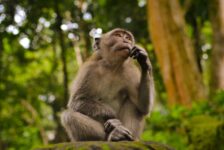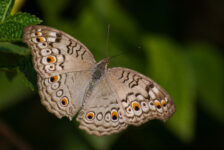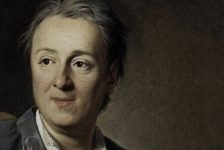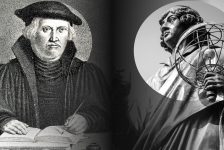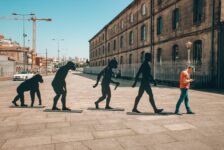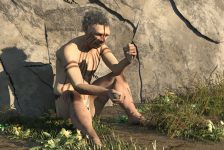Introduction: Natural Selection – evolution route
Natural selection is a process that consists of the elimination of species members having non-viable traits and preservation of members that are most adapted to their current habitat. The former generally cannot survive the competition and cease to pass their traits to offspring, whereas the latter succeed inbreeding. This selection is, in some ways, similar to technological innovations. Whenever a novel technology is introduced that corresponds to consumer requirements and is advantageous/more convenient over previous technology within that market segment, it typically prevails to become a market leader, rendering previous prototypes obsolete, which become less competitive and eventually go extinct. Natural selection operates in a similar manner, with the main distinction being that it is nature – not the people (consumers) – that drives the selection process, with this being significantly more time-consuming, as it can involve tens and hundreds of millions of years.
Competition can arise between individuals of the same species, between distinct species, and with physical conditions of life. Rivalry is fiercer between individuals of the same species since they share the same niche (fulfill identical roles in their environment) and therefore require identical living conditions. Regarding distinct species, competition is not as fierce since their niches are not exactly the same; a possibility for niche overlapping exists (e.g., two differing predators preying on the same animals), though typically, the niches vary greatly due to belonging to differing species. Richard Dawkins also explained this in The Selfish Gene:
Survival machines of the same species tend to impinge on each others’ lives more directly. This is for many reasons. One is that half the population of one’s own species may be potential mates, and potentially hard-working and exploitable parents to one’s children. Another reason is that members of the same species, being very similar to each other, being machines for preserving genes in the same kind of place, with the same kind of way of life, are particularly direct competitors for all the resources necessary for life. To a blackbird, a mole may be a competitor, but it is not nearly so important a competitor as another blackbird. Moles and blackbirds may compete for worms, but blackbirds and blackbirds compete with each other for worms and for everything else.1
Darwin also acknowledged this fact in his renowned Origin of Species:
As species of the same genus have usually, though by no means invariably, some similarity in habits and constitution, and always in structure, struggle will generally be more severe between species of the same genus, when they come into competition with each other, than between species of distinct genera.2
Moreover, selective pressure causes competition, though it is important to point out that natural selection itself is not synonymous with evolution; it is one – but not the only – means by which evolution might occur. Evolution itself can be defined as a gradual accumulation of variations in species which, after a sufficiently lasting time span, result in the emergence of new distinct species, which is a classic example of gradualism. There also exists an alternative idea known as punctuated equilibrium, which, in contrast to gradualism, denotes a swift change in population that is followed by a period of stability (stasis).
Science of genetics meets evolution
It is also important to understand how deviations from standard features arise in nature. Since this mechanism is directly related to genetics, which was explored in enough detail only during the following century after Darwin’s publication, this was regarded as an enigmatic aspect of evolutionary theory. However, when scientists ultimately explored and decoded DNA molecules, genetics was incorporated into and complemented evolutionary theory. Mutations – or errors – were found to be responsible for deviations from standard traits. Mutations during the processes of transcription (responsible for DNA replication) and translation (responsible for conversion of nucleotide sequences into amino acids and proteins), and other mutations (e.g., inversion or deletion) can be sufficient to result in tangible changes in structure and/or appearance (phenotype) over generations. Whether such deviations will be favored or not is determined by external conditions. This is provided that the new trait supports the survival of an individual, thus giving it a competitive edge over its rivals, the individual itself will be more likely to succeed in the struggle for survival and producing offspring. Ultimately, the odds of transferring such novel phenotypic traits (which allowed a species member to survive) to the offspring increase drastically.
In addition, the frequency of this gene allele (variant), leading to such a novel trait, will rise within the population. Subsequently, it would be reasonable to assume that in conditions where struggle for existence is weakened (either by abundance of resources or other factors), trait shifts tend to be more frequent since the given trait’s influence on individual survival is weakened, and it therefore becomes more variable as selective pressure is reduced.
How evolution results in the emergence of new species
Genetic mutations, the struggle for existence, and natural selection are all factors contributing to evolution. As described above, evolution refers to the accumulation of novel traits. Eventually, individuals of the same species living in isolated areas (separate populations) can develop various adaptions to the environment in order to enhance their own survival; given enough time and mutations, such adaptations will accumulate, with individuals of the original population becoming so distinct in their genetic makeup that natural breeding becomes impossible, and this is what defines a separate species. It is at this point that species are known to diverge. However, it is occasionally misunderstood that such adaptations – which cause divergent evolution – are absolute and perfect in their character. Darwin writes,
Natural selection tends only to make each organic being as perfect as, or slightly more perfect than, the other inhabitants of the same country with which it has to struggle for existence. Therefore, natural selection will not produce absolute perfection, nor do we always meet, as far as we can judge, with the high standard under nature.3
There are many flaws within biological adaptations, though they are still preserved since they are relatively successful.
Unit of evolution and why selfless behaviour may be favored by natural selection
Natural selection was once believed to act only for the individual’s own good, though later it was proposed that behavior which harms the individual, though assists its society, can also be preserved. In fact, it is none other than genes that benefit, rather than the society, or species, or group as a whole.
This was elaborately developed by Richard Dawkins in The Selfish Gene:
I shall argue that the fundamental unit of selection, and therefore of self-interest, is not the species, nor the group, nor even, strictly, the individual. It is the gene, the unit of heredity.4
What follows is that individuals are survival machines, existing to propagate their own genes. Since one individual is not the only machine with the given genes. For example: a honey bee’s self-sacrifice makes sense as, in this way, it defends other bees (with whom it shares certain genes) by deterring predators through stinging, thus protecting a hive and/or bee family. Although the analysis of evolution from genomic perspective is a relatively recent concept, this seemingly altruistic behavior of bees was described as far back as in 1859 by Darwin:
If we look at the sting of the bee, as having originally existed in a remote progenitor as a boring and serrated instrument, and which has been modified but not perfected for its own purpose, with the poison originally adapted to cause galls subsequently intensified, we can perhaps understand how it is that the use of the sting should so often cause the insect’s own death: for if on the whole the power of stinging be useful to the community, it will fulfill all the requirements of natural selection, though it may cause the death of some few members.5
Population growth and its reference to the struggle for existence
Darwin defined causes of struggle for existence in the following manner:
A struggle for existence inevitably follows from the high rate at which all organic beings tend to increase. Every being, which during its natural lifetime produces several eggs or seeds, must suffer destruction during some period of its life, and during some season or occasional year, otherwise, on the principle of geometrical increase, its numbers would quickly become so inordinately great that no country could support the product.6
When referring to this concept, it is impossible not to mention Thomas Malthus, who proposed that there are natural restrictions that place constraints on population growth. He claimed that in the absence of such conditions as scarcity of food, disasters, and disease, a population would grow in geometric pattern (exponentially). However, the above-described factors are more often present than not. Initially, the population growth rate will increase, although once it reaches a critical peak value, the trend will reverse, and the rate will approach zero as population approaches to its maximum value. Population reaches a plateau with time, which reflects the actual situation in nature. The population can oscillate around the upper limit but cannot surpass it significantly, unless the limit itself is elevated due to condition changes such as additional resources being made available to the population. This model is integral to the concept of struggle for existence since it states that a population cannot reproduce infinitely, and, eventually, individuals will compete for survival.
Indeed:
Can we doubt (remembering that many more individuals are born than can possibly survive) that individuals having any advantage, however slight, over others, would have the best chance of surviving and of procreating their kind? On the other hand, we may feel secure that any variation in the least degree injurious would be rigidly destroyed. This preservation of favourable variations and the rejection of injurious variations, I call Natural Selection.7
Three forms of natural selection
Stabilizing Selection refers to relatively stable conditions and the abundance of resources. When a species is influenced by this form of natural selection, the frequency of the mean trait becomes greater, whereas individuals with marginal deviations are less likely to be preserved. Such trait distribution implies that populations in post-stabilizing state are more uniform as there is a higher frequency of average feature and a lower frequency of digressing ones.
Some well-known instances to this type of selection are often called living fossils, which include hatteria and latimeria, among other examples. Their exceptional adaptions allowed them to be preserved by natural selection, and due to the stability and sustainability of their habitats, they were able to outcompete their rivals and reproduce.
Directional selection, conversely, is relevant for the population at the stage of changing conditions when the environment is unstable. In such conditions, when a new trait emerges – provided that it renders an individual more competitive – it gradually increases in its frequency of distribution while an original one becomes less disseminated. This confirms the relative character of adaption because a feature that was beneficial for the species’ survival in one habitat may be at least useless and at most detrimental in a new one. In directional selection, the frequency of the mean trait remains constant while the very definition of mean trait changes.
One of the most common examples of species which were exposed to the directional selection is a butterfly Biston betularia. Due to air contamination in an industrial area, the tree bark was darkened, and the species’ characteristic white colour rendered it more visible to predator birds and thus more susceptible to be eaten by them. In this manner, previously unfavorable dark colour suddenly became an essential contributor to the butterflies’ survival.
Finally, disruptive selection can be rather complicated to comprehend since it may contradict logic. In this type of selection, it is not the species with features closest to the mean that survive and thrive but, conversely, the ones with the biggest digressions from the average.
There are similarities between natural disruptive selection and the artificial one, in which humans choose traits that are most useful for them; it is clear that these are not necessarily – and most often not – the mean traits but deviations:
One of the most remarkable features in our domesticated races is that we see in them adaptation, not indeed to the animal’s or plant’s own good, but to man’s use or fancy.8
Conclusion: theory of Evolution – the indisputable truth
As with all theories, the theory of evolution must satisfy the following condition: it must explain a specific set of events it must be able in the way that can be either empirically proved or falsified. Undoubtedly, evolutionary theory does clarify how all living creatures emerged, and there are abundant proofs; for instance, a famous lab experiment conducted by Richard Lenski revealed strong evidence that bacteria could develop an ability that was not peculiar to this species (it evolved in laboratory conditions):
The biggest evolutionary shift occurred after about the 31,500th generation, when one line in one of the 12 populations evolved the ability to feed on citrate, another chemical in the growth medium. E. coli don’t normally feed on citrate because they can’t carry it into their cells.9
As any theory, evolution could be disproved if any evidence obtained using scientific method suggested that evolution does not occur. No such evidence was ever found, and evolution remains a valid theory to describe development of organic world. Science is open about new inquiries, but evolution is a well-secured fact that still could not be falsified by contradicting evidence. Once when well-known biologist J.B.S. Haldane was asked what could disprove evolution, he replied: “Fossil rabbits in the Precambrian.”10 He meant that only several fossil samples found not to agree with the theory would suffice to disprove it. No such instances were ever discovered. Darwin himself had a viewpoint that science can find solutions to the most intimidating challenges, which is clearly expressed in his statement:
It has often and confidently been asserted, that man’s origin can never be known: but ignorance more frequently begets confidence than does knowledge: it is those who know little, and not those who know much, who so positively assert that this or that problem will never be solved by science.11
Developing predictions can be difficult because the very source of variation in population are random genetic mutations (this does not mean that Natural Selection itself is random – it is exactly the opposite). Relations between organisms within an ecosystem are extremely intricate, and it is fairly difficult to reveal by what indirect way, such as extinction (or fluctuations) of one population can affect the other. This factor of uncertainty, however, does not invalidate evolution, as numerous fossils were – and continue to be – discovered which clearly demonstrate diversification of species. Evolution is certainly true, and researchers continue to discover fascinating evidence which accrue to what is already known. There is almost a universal consensus in science that ‘As surely as dropped objects fall, life has evolved and continues to do so’.12
The original paper with mathematical demonstrations can be found here.
References
1 Dawkins, Richard, ed.2006. The Selfish Gene. p.125. ACT Publication, Moscow. Translated by N.Fomina.
2 Darwin, Charles. 1859. The Origin of Species, p.69. Wordsworth Classics of World Literature.
3 Darwin 1859, 155.
4 Dawkins 2006, 47.
5 Darwin 1859, 155.
6 Darwin 1859, 50.
7 Darwin 1859, 63-4.
8 Darwin 1859, 25.
9 New Scientist Instant Expert. 2017. How Evolution Explains Everything about Life. p.161. John Murray Learning.
10 New Scientist Instant Expert 2017, 123.
11 Darwin, Charles. 1871. The Descent of Man. p.4. Wordsworth Classics of World Literature.
12 New Scientist Instant Expert 2017, 135.



